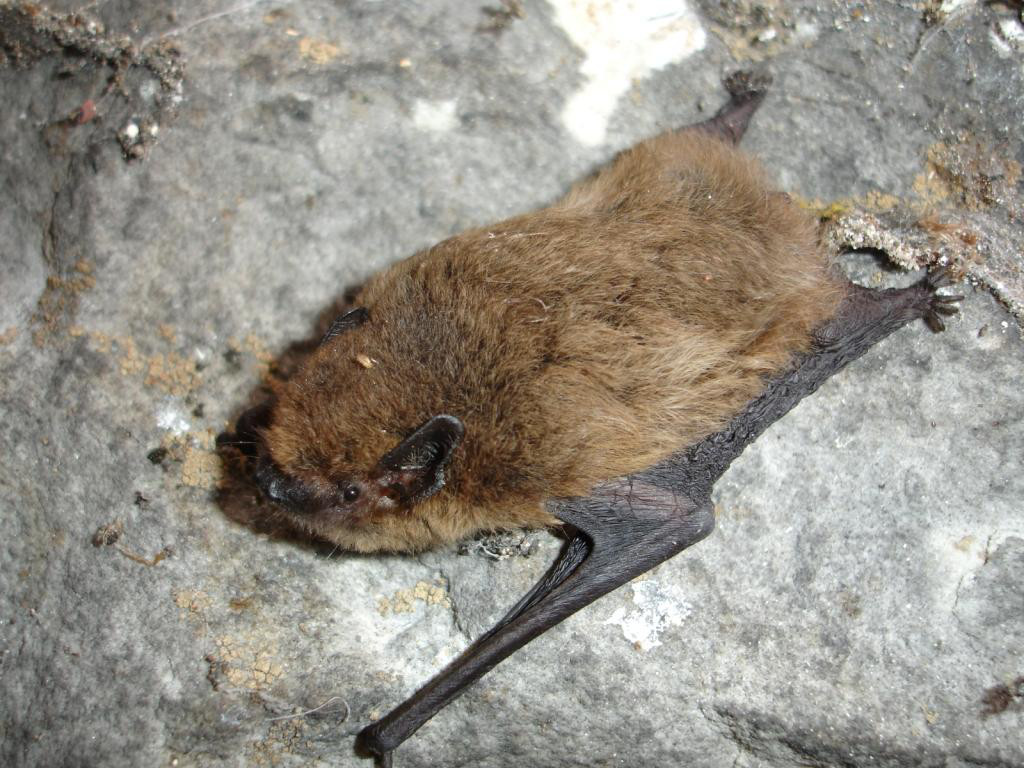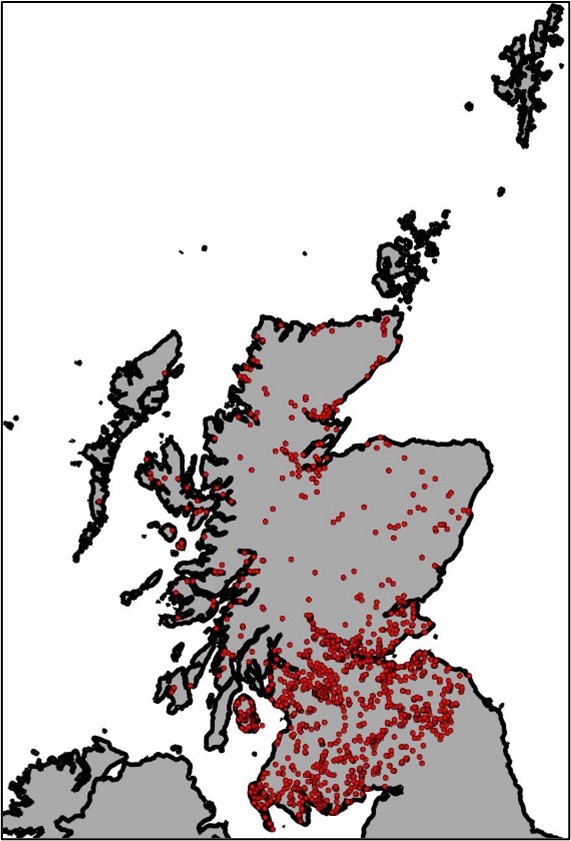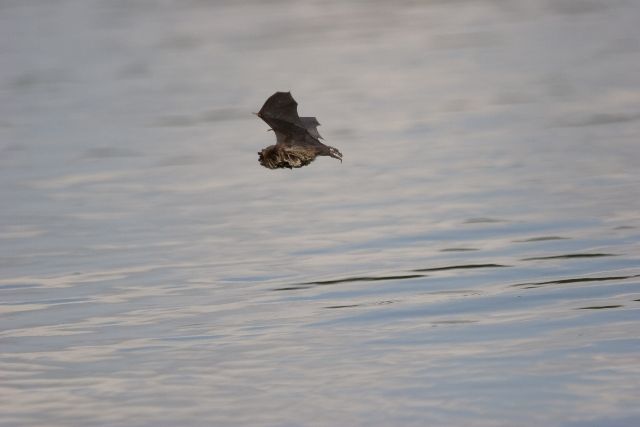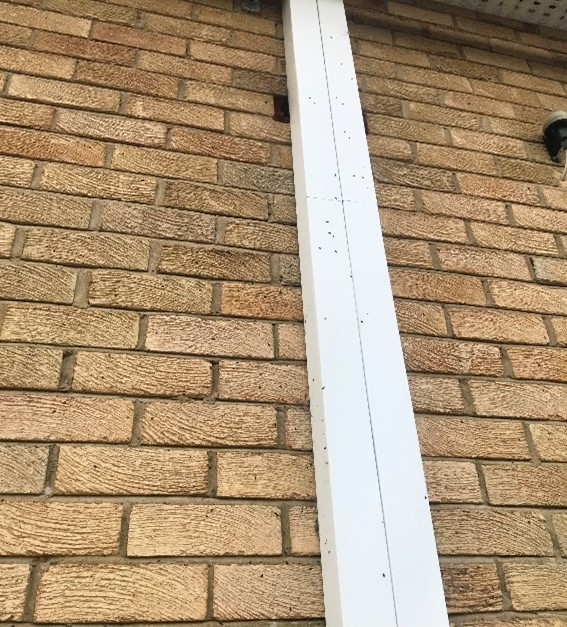Bats and Biodiversity
26 April 2024If you are out on the farm around dusk or dawn during the summer months, you might spot bats fluttering through the sky, when little else is active but you and them. Of the 10 bat species found in Scotland, all can be found using farmland where conditions are suitable to support them. Their presence on farmland can mean: you have a source of free pest control, your farm supports the diversity in habitats required for that species, and it can mean you have a legally protected roost on your farm. Below we highlight the importance of bats across our farming landscape, why bats can be good for business, and five actions you can put in place to support bats.
Why bats on your farm are a good sign
Seeing bats flutter around a specific area of your farm means two things:
- This area has an abundance of flying insects (the sole food of these insectivorous species).
- Your farm is providing vital resources for some of Scotland’s rarest species.
Bats come out to feed on insects at night, so you are likely to see them any time from half an hour before sunset to half an hour after sunrise. If you are out on the farm around this time you might see a bat darting around the sky and amongst trees and buildings. The bat has either came from a roost on the farm, or has travelled to the farm to forage on insects. If you see a bat within 30 minutes of sunset, it hasn’t travelled far and most likely there is an active roost either on, or close to, your farm!
Bats play a critical role as a key predator in the food chain. Through millions of years of evolution, bats have filled the niche in our skies that birds leave when night falls. They predate on a diverse range of insects, including those we see during the day, as well as those that are predominantly more active at night. Bats therefore apply a top-down pressure on to insect populations that is vital in maintaining healthy ecosystems.
Within an agricultural setting, bats can act as a natural control method for pest insects on both crops and livestock. While scouring the night sky for prey, a single bat can eat up to 3,000 midges in one night. Over the world bats are utilised for their natural pest control services. In North America, through catching and killing adult insects reducing larvae in crops, bats have been estimated to be worth $22.9 Billion per year to crop protection. In Europe, bats are often encouraged by livestock farmers, as they predate on blood sucking insects that bother their cattle.
Bats are described as ‘indicator species’ for biodiversity. For bats to thrive they require adequate roosting opportunities, foraging habitat and connected landscape features like hedgerows, tree lines and watercourses which help them commute between roosting and feeding locations. As well as this, they require a healthy abundance of insects to feed upon. Therefore, noticing where bats are, and are not occurring across your farm, can help highlight areas of healthy biodiversity, and areas where enhancements could be best implemented.
Species of bats
Common pipistrelle
Pipistrelle pipistrellus

Common pipistrelle © Rosie Corner / www.bats.org.uk.
Summer Roosts: Buildings, barns, churches and houses.
Winter Roosts: Trees, houses and underground.
Foraging habitat: Almost anywhere, specifically Woodland edge, hedgerows, and tree lines.
Map: NBN Atlas occurrence download at https://nbnatlas.org accessed on 15 April 2024

Soprano pipistrelle
Pipistrelle pygmaeus

Soprano pipistrelle © Daniel Hargreaves / www.bats.org.uk.
Summer Roosts: Buildings, barns, churches and houses.
Winter Roosts: Trees, houses and underground.
Foraging habitat: Habitats associated with water, such as rivers, lakes and riparian woodland.
Map: NBN Atlas occurrence download at https://nbnatlas.org accessed on 15 April 2024

Nathusius’ pipistrelle
Pipistrelle nathusii

Nathusius pipistrelle © Hugh Clark / www.bats.org.uk.
Summer Roosts: Houses and trees
Winter Roosts: Trees, houses and underground.
Foraging habitat: Riparian, Woodlands, Estuaries. Preys on flies and moths.
Map: NBN Atlas occurrence download at https://nbnatlas.org accessed on 15 April 2024

Brown long-eared
Plecotus auritus

Brown long-eared © Hugh Clark / www.bats.org.uk.
Summer Roosts: Barns, churches, large roof spaces, old trees.
Winter Roosts: Trees and underground.
Foraging habitat: Woodland, preys on moths, beetles and other large insects.
Map: NBN Atlas occurrence download at https://nbnatlas.org accessed on 15 April 2024

Noctule
Nyctalus noctula

Noctule © Martin Celuch / www.bats.org.uk.
Summer Roosts: Old trees, sometimes buildings.
Winter Roosts: Trees and underground.
Foraging Habitat: Open areas, woodlands, wetlands or grasslands. Preys on crickets, dung beetles, moths and flies.
Map: NBN Atlas occurrence download at https://nbnatlas.org accessed on 15 April 2024

Leisler's
Nyctalus leisleri

Leisler's © Hugh Clark / www.bats.org.uk.
Summer Roosts: Old trees, sometimes buildings.
Winter Roosts: Trees and underground.
Foraging Habitat: Forest and woodlands. Preys on midges and dung flies, moths and beetles.
Map: NBN Atlas occurrence download at https://nbnatlas.org accessed on 15 April 2024

Duabenton's
Myotis daubentonii

Duabenton's © Kevin Durose / www.bats.org.uk.
Summer Roosts: Broadleaved woodlands, bat boxes, buildings and bridges.
Winter Roosts: Trees and underground.
Foraging Habitat: Riparian habitat over still water. Preys on aquatic invertebrate on water surfaces.
Map: NBN Atlas occurrence download at https://nbnatlas.org accessed on 15 April 2024

Natterer's
Myotis nattereri

Natterer's © Hugh Clark / www.bats.org.uk.
Summer Roosts: Trees, bat boxes, barns, churches and old houses, all within 500m of woodland.
Winter Roosts: Trees and underground.
Foraging Habitat: Woodlands, tree-lined river corridors, trees in parklands, hedgerows and pastures. Preys on midges and dung flies.
Map: NBN Atlas occurrence download at https://nbnatlas.org accessed on 15 April 2024

Whiskered bat
Myotis mystacinus

Whiskered bat © Derek Smith / www.bats.org.uk.
Summer Roosts: Buildings, sometimes trees and bat boxes.
Winter Roosts: Underground.
Foraging Habitat: Linear features such as tall hedgerows, woodland edges and watercourses.
Map: NBN Atlas occurrence download at https://nbnatlas.org accessed on 15 April 2024

Brandt's bat
Myotis brandti

Brandt's bat © Hugh Clark / www.bats.org.uk.
Summer Roosts: Buildings, sometimes bat boxes, bridges and trees.
Winter Roosts: Underground.
Foraging Habitat: Woodlands, grassland and scrub. Frequent along linear features.
Map: NBN Atlas occurrence download at https://nbnatlas.org accessed on 15 April 2024

Why are bats protected and what does this mean?
All species of bats have seen a sharp decline over the last 50 years. Rapid intervention was therefore required to ensure that these species did not decline to extinction, allowing their numbers to be revived to healthy levels.
The decline was due to a multitude of reasons: The increase in use of pesticides decreased invertebrate populations, and therefore gave bats less to feed on. The removal of hedgerows meant that bats didn’t have corridors through the countryside to navigate. Loss of semi-natural habitats such as woodland, ponds and species-rich grasslands reduced invertebrate numbers and resulted in a loss of roosting sites and shelter.
As such, legal protection was placed on bats to help their numbers recover. All bat species are European protected species and receive full protection under the Conservation (Natural Habitats, &c.) Regulations 1994 (as amended). This means it is a legal offence to damage or destroy somewhere a bat uses to roost, either for breeding or resting purposes. It is also an offence to deliberately or recklessly disturb a bat in a roost or obstruct access to a bat roost.
Where might you find bats around the farm steading?
When not flying and hunting, bats require shelter that is dry, safe and the right temperature - this is referred to as their roost. Within the natural environment, these roosts can be found in old trees, caves and rock fissures. However, as human societies developed, removing these natural features to build homes and buildings, bats have adapted to making roosts within our buildings.
Old farm buildings with gaps, cracks and vacant roof spaces will provide a range of conditions ideal for bats to roost in throughout the year.
The bat species in Scotland that use buildings to roost can be divided into three different categories:
- Crevice-dwelling bats – Common pipistrelle, Soprano pipistrelle, Nathusius’ pipistrelle and whiskered bat.
- Roof dwelling bats – Leisler’s bat and Daubenton’s bat.
- Bats that need flight space in certain types of roosts – Natterer’s bat and brown long-eared bat.
Each species requires a variety of roosts, offering different conditions, throughout the year. The most common and important roosts are:
- Day roost – A place where individual bats, or small groups, rest or shelter in the day during the summer. These are used during the active summer months, usually frequented by males while the females form maternity roosts.
- Maternity roost – A place where females give birth and raise their young to independence. In some species, males may also be present in the maternity roost. These occur in early summer and generally require warm dry conditions between 30-40°C.
Hibernation roost – A place where bats may be found individually or together during the winter. Bats begin to hibernate around November, and look for cool humid spaces, where they drop their body temperature and begin hibernation.
Farm buildings and their features for bat roosts
Farm buildings offer many different conditions, and so can support a multitude of bat species as well as multiple kinds of roosts.
Many crevice-dwelling species, such as pipistrelles, do not require large openings to enter roost spaces. Bats can fit into holes as small as 1.5cm x 2cm, and smaller entrances which prevent water from entering and heat escaping can be preferable to bats. Small cracks and gaps in stone walls could provide enough room for a couple of bats to roost, or alternatively provide access into a building where many bats roost in the larger space.


Cavity walls within buildings can also provide suitable conditions for bat roosts. A crack in the exterior wall or a door frame could allow bats to access these areas. Cavity walls also often provide stable cool conditions, offering perfect conditions for hibernation roosts.
Loft spaces in farm buildings can provide roomy warm conditions for pregnant females to gather, give birth and raise their young. These can often be accessed from gaps in tiles, loose soffit vents or loose bricks above the roof space. The presence of bats within a building can be observed by looking out for them emerging around dusk during the summer, or checking for droppings in and around potential entrances. It is important to do this with care to avoid disturbing any potential bats roosting.

Farm habitats beneficial to bats
Hedgerows
Bats are reliant on echolocation to move around landscapes, where super high frequency calls bounce off surrounding objects and return to their ear to build an image of their surroundings in their mind in the absence of light. Hedgerows act as 3D structures for these calls to bounce off, running great lengths through our countryside, and so providing a route for bats to follow to access new habitats, allowing populations to grow and spread.
Trees in fields
Old trees scattered across fields within the farmed landscape are vitally important to providing shelter for commuting and foraging bats. Old gnarly trees with cavities, broken limbs and cracks provide excellent habitat for bats to roost within during summer months.
Ponds
All bat species require a source of water to drink from, while some species such as Daubenton’s are specialised to feed on insects associated with aquatic habitats (e.g. mayflies, stoneflies and caddisflies). Ensuring ponds are scattered throughout the landscape, and contain water of good quality to support aquatic invertebrates helps bats move across the landscape. This can be achieved through the creation of new aquatic habitat such as ponds, or improving the water quality of existing water habitats, through fencing off to prevent pollution.
Species-rich grasslands
Species-rich grasslands, with their diversity and abundance of plants, support a diversity of insects. This provides an insect-all-you-can-eat buffet for bat species to feed upon. Insect-rich habitats provide the necessary resources for bats to produce milk for their young and put on fat to survive the winter.
Woodlands
Woodlands provide both a wide range of roosting habitat and plenty of insects to forage upon. Where woodlands have a range of tree species, a diverse understory, and plenty of deadwood insect diversity will be greatest, supporting high numbers of bats. Clearings are beneficial within woodlands as the open space allows bats to navigate their way in and around trees.
Five top tips to increase bats on your farm
Hover for more information
1. Reduce steading light pollution
1. Reduce steading light pollution
Light pollution during the night disturbs the natural rhythms of many nocturnal animals. Many slower moving bat species will avoid well-lit areas for feeding and roosting. Consider if there are any steading lights on during the evening that could be turned off.
2. Install bat boxes around the farm
2. Install bat boxes around the farm
While old farm buildings contain plenty of features which make them suitable for bats, many new buildings are a lot more sleek and therefore don’t provide any opportunity for bats. Installing bat boxes gives them somewhere to roost, and will result in greater insect predation around the steading. When installing bat boxes, ensure they are 4m off the ground, away from artificial light, sheltered from strong winds, and are exposed to sun for part of the day (south, south-east, or south-west facing). Consider where on the farm bat boxes could be sited (e.g. farm buildings, trees, or woodland edges).
Find more information in our article Making a Home for Bats on Your Croft | Helping farmers in Scotland | Farm Advisory Service (fas.scot)
3. Plant trees around the steading and across the farm
3. Plant trees around the steading and across the farm
Trees around the steading will help build insect populations to help support bat populations. While trees scattered across the farm will help bats traverse across the wider landscape, allowing populations to mix and expand. Consider growing your own trees using seeds from existing trees on the farm. Keep an eye out for fenced off pockets of the farm where trees could be easily planted in.
4. Leave ivy and shrubs on trees and buildings where it exists
4. Leave ivy and shrubs on trees and buildings where it exists
Ivy and shrubs around buildings and trees support an abundance of insects, providing food for bats. Thick ivy can provide shelter for bats to temporary roost behind. Consider where on the farm has existing ivy and shrubs and whether it can remain. Where could more be safely added?
5. Create habitats beneficial to bats across the farm
5. Create habitats beneficial to bats across the farm
A diversity of habitats beneficial to bats (ponds, hedgerows, open woodlands, treelines, species-rich grasslands) will help support good numbers of bats on the farm, and across the landscape. How many of the bat beneficial habitats does your farm contain? Where might there be scope to implement another?
Harry Fisher, SAC Consulting
Images courtesy of the Bat Conservation Trust
Publication image Brown long-eared bat © Hugh Clark / www.bats.org.uk.
Sign up to the FAS newsletter
Receive updates on news, events and publications from Scotland’s Farm Advisory Service
